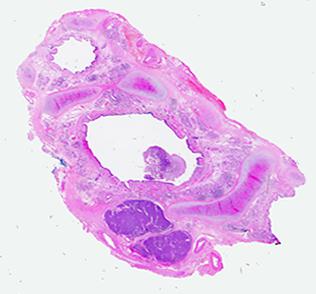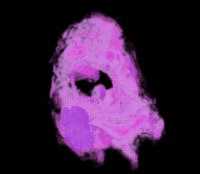|
Using FATCAM and Autoreg to Make 3D VRML Models from Serial Sections
FATCAM is a GUI Windows program I wrote as part of my Ph.D. into advanced tissue imaging at Imperial College. It stands for Flexible Assignment of Transparency and Colour-based Alpha Mapping.
You can download it from the Downloads page on this site.
You might ask 'isn't this yet another 3D modelling from serial sections program?' Yes and No. Yes, in the sense that anything you can do with other 3D modelling methods you can do using these programs. No, in the sense that by means of the highly flexible transparency mapping allowed by FATCAM, one can make 3D models of information-intense objects such as bright-field microscopy. Most commercial solutions focus on fluorescence data as this is essentially simple - different intensities of one, two or three fluorophores in a black background. However, bright field imagery contains a wealth of visual detail and colour which overwhelms the visualisation abilities of other modelling software.
I use VRML as the output medium as this is a good interactive interface for 3D visualisation on home computers making the most of your computer's graphics card abilities and therefore less dependent on the main processor specifications. Also VRML is FREE. Download the Cosmo Player VRML plug-in from http://ovrt.nist.gov/cosmo/. Once such a plug-in is installed you will be able to manipulate VRML models. As an example, download a (very low resolution) test model to try out by clicking here.
The results of applying Autoreg and FATCAM to serial sections of a bronchial carcinoid tumour are shown above. The examples below are low resolution for ease of Internet downloading. Models can be made to any desired resolution (limited only by the local computer capacity and graphics card ability). Unlike other VRML models, FATCAM was designed to give the model true internal structure rather than just being a hollow shell and so FATCAM-generated models are suitable for true volumetric visualisation.
All images were scanned in on a high resolution transparency scanner and so do not have cellular resolution (although this could have been achieved by using a microscope and digital camera).
Once registered with Autoreg, FATCAM and BiaQIm were used together to
effect a transparency mapping based on natural colour content.
FATCAM then converts the bmp files into PNG format with full alpha support and weaves a 3-dimensional lattice of planes into a VRML model. A low resolution image of this model is shown above. The VRML model allows full user interactive control of the model in 3D.
Although VRML was designed for sharing models over the Internet, FATCAM-generated VRML files can be very large for high resolution volumetric datasets. It is intended that such models should be viewed on the local computer on which they are stored rather than over a network. In this way, VRML (plus a good
graphics card) allows you to use an ordinary PC as a graphics workstation.
|









 Dr P. J. Tadrous 2000-2024
Dr P. J. Tadrous 2000-2024